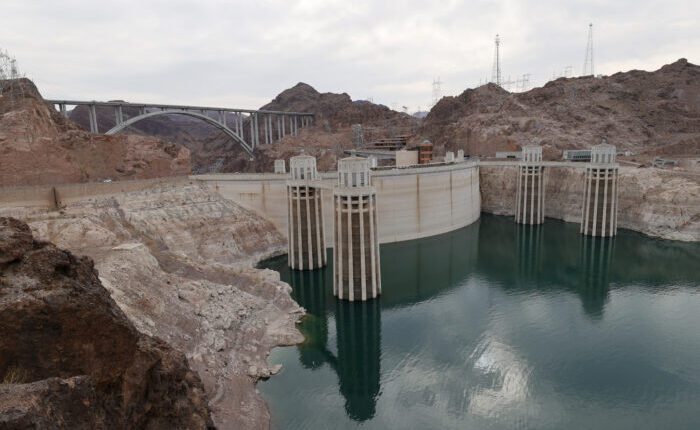
Federal Funding Fuels Colorado River Conservation Efforts
TL/DR –
Despite a megadrought, Western states have avoided drastic cuts to their allocations of Colorado River water this year due to generous financial incentives from government levels encouraging conservation, surprising storms, and the temporary water-sharing agreement between Arizona, California, and Nevada. In total, the federal government will spend $15.4 billion on drought resiliency programs over the coming years, funded by the Inflation Reduction Act and the Bipartisan Infrastructure Law. However, water experts worry that paying people to conserve isn’t a long-term solution, and call for states to make long-term investments and rethink water-sharing agreements for the Colorado River’s survival.
Discover more Stateline coverage on the impact of climate change induced drought across Western communities.
Unexpected storms and government incentives have enabled Western states to stave off severe Colorado River water cuts despite a mega-drought.
The $1.2 billion federal government funding injection is crucial to the Colorado River water-sharing agreement recently announced by Arizona, California and Nevada. Thirty tribal nations in the river basin, including the Gila River Indian Community, also benefit from federal dollars, largely for water conservation purposes.
Influenced by the Inflation Reduction Act and the Bipartisan Infrastructure Law, the federal government plans to allocate $15.4 billion towards drought resiliency programs primarily designed for water storage, recycling projects and public water conservation encouragement.
While incentivizing conservation is effective short-term, water experts stress the necessity for long-term state investments and revised water-sharing agreements to help the Colorado River endure.
Federal dollars have helped prevent severe water cuts that would have adversely affected 40 million residents across seven Western states that rely on the Colorado River, according to Michael Cohen, a senior researcher at the Pacific Institute.
The approach to incentivize people has seen success. Yet, it remains uncertain if we can achieve the necessary system stabilization through further reductions.
Cohen mentioned that the federal government commonly provides financial aid during disasters, with the ongoing drought being no exception.
Western states have long offered financial incentives to farmers and residents to conserve water, such as refraining from crop irrigation and installing water-efficient appliances.
Cities in Arizona, including Gilbert and Scottsdale, provide residents with substantial financial incentives to replace grass lawns with native desert plants.
For two decades, Las Vegas has incentivized residents to replace their grass lawns with desert-appropriate plants, significantly reducing the city’s annual water consumption.
Upcoming negotiations
The Bureau of Reclamation has requested long-term water conservation proposals from states in preparation for the worsening drought conditions anticipated due to climate change.
Last year, the agency presented states with two options to safeguard the Colorado River against the ongoing megadrought effects: voluntary water use reduction with compensation or federally mandated cuts.
The May agreement allows the lower basin states to decrease water use by 3 million acre-feet over three years. Federal funding facilitated this agreement, averting disaster this year thanks to a particularly wet winter and summer storms in the Southwest.
George Frisvold, a University of Arizona professor, describes this as a temporary solution and predicts challenges ahead.
The broader conservation strategy might evolve, with future scrutiny over federal spending results and a potential shift towards local funding for conservation, according to Frisvold.
States are preparing for negotiations on a long-term Colorado River water-sharing agreement for post-2026. A significant challenge is determining agriculture’s role in Colorado River water conservation.
Money for agriculture
Western agriculture, a key economic contributor and major user of Colorado River water, has used federal and local funds to conserve water through canal lining, drip irrigation systems installation, and temporary crop growth cessation.
Mike Wade, executive director of the California Farm Water Coalition, highlights Southern California’s successful model of urban water users compensating inland farmers to transfer a portion of their Colorado River water share to cities.
Wade envisions local governments making these investments for long-term sustainability, preventing mandatory cuts and supporting communities and businesses.
However, there is contention over the sustainability of farmer payments as a solution. Mark Gold, director of water scarcity solutions at the Natural Resources Defense Council, argues for a change in approach. He considers farmer payments an inefficient, unsustainable method to save water.
Katherine Wright, a research fellow at the Property and Environment Research Center, advocates for private water allocation transfers between farmers and cities as a long-term solution without federal funding.
Read More US Economic News
